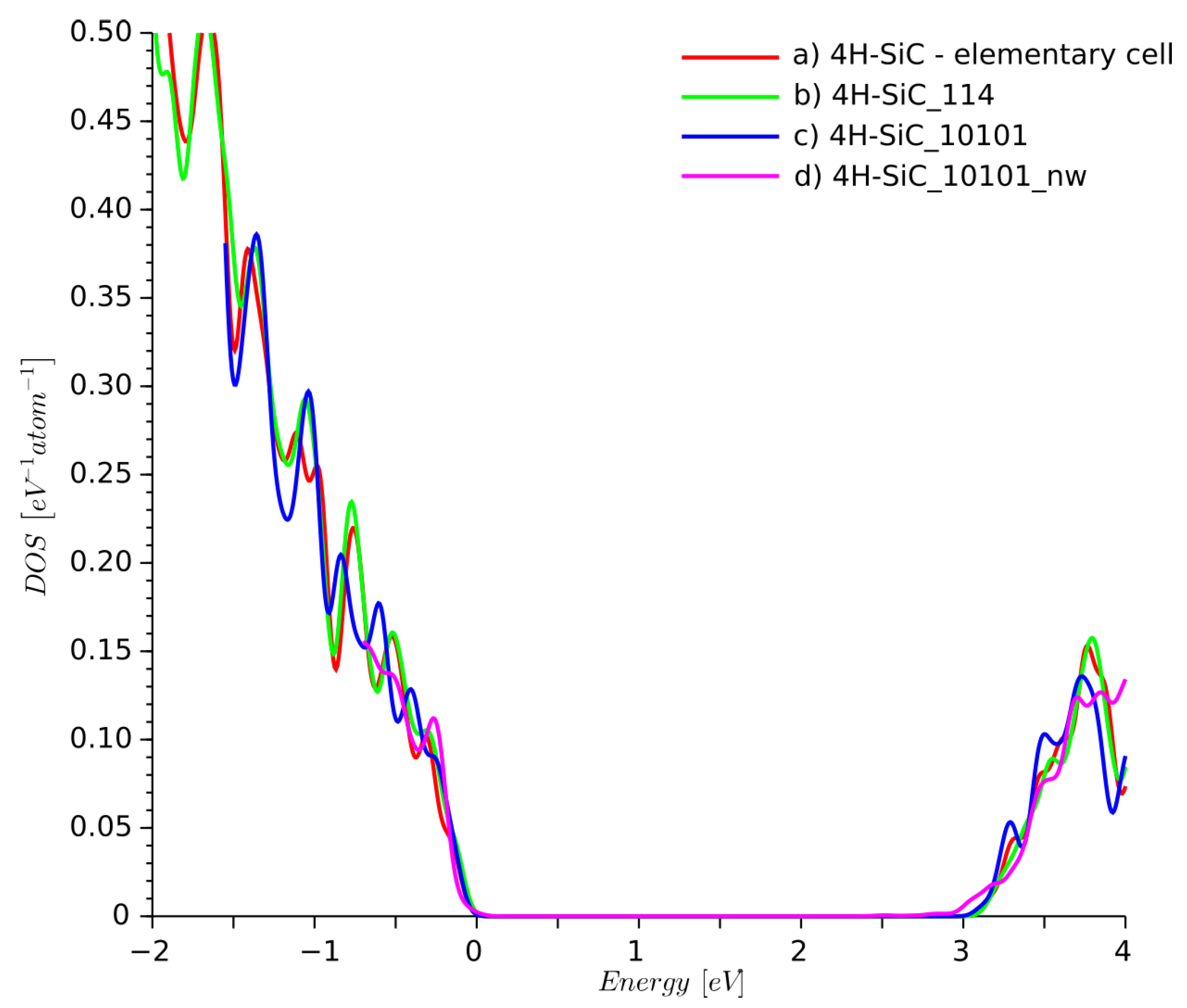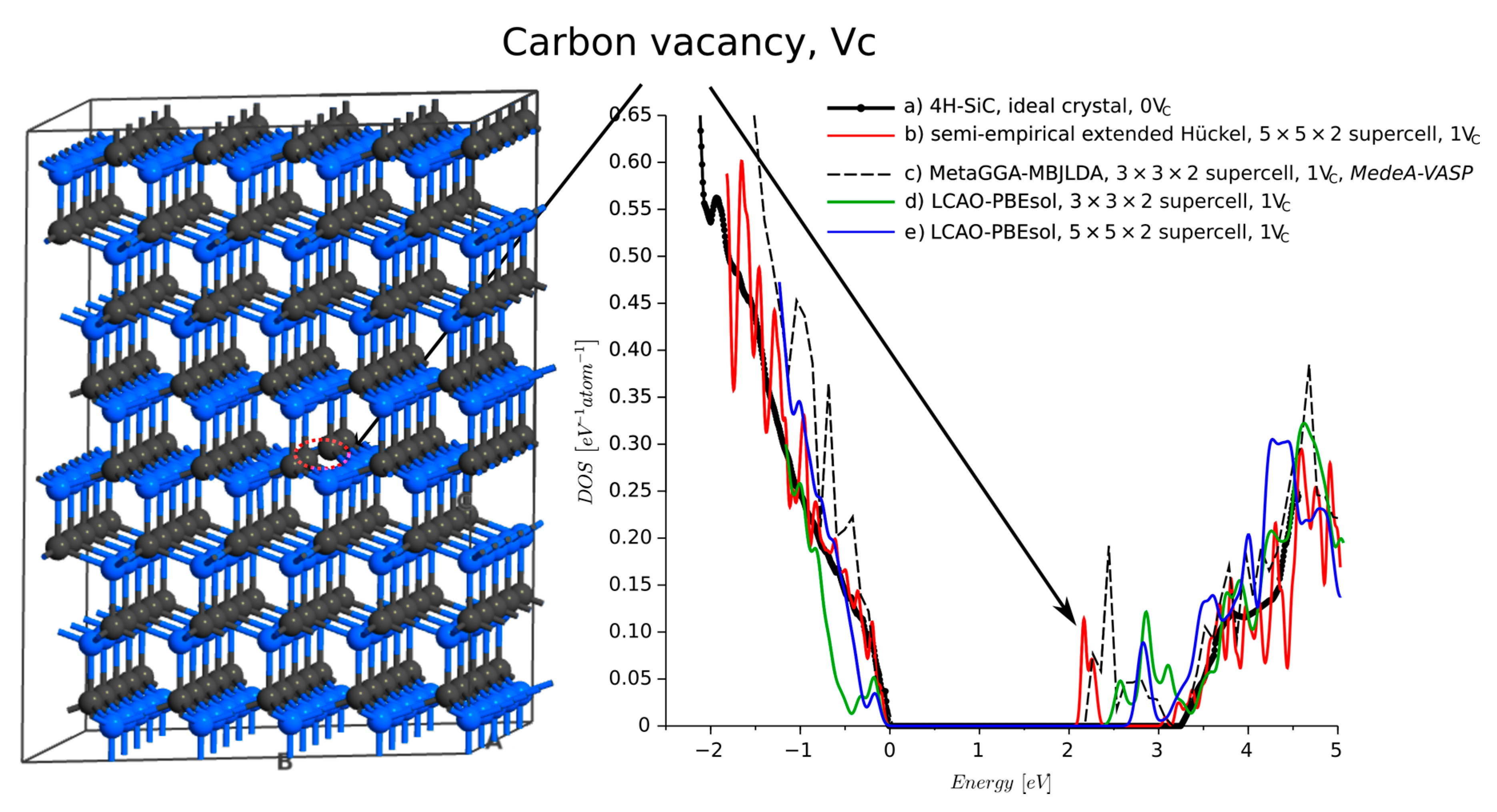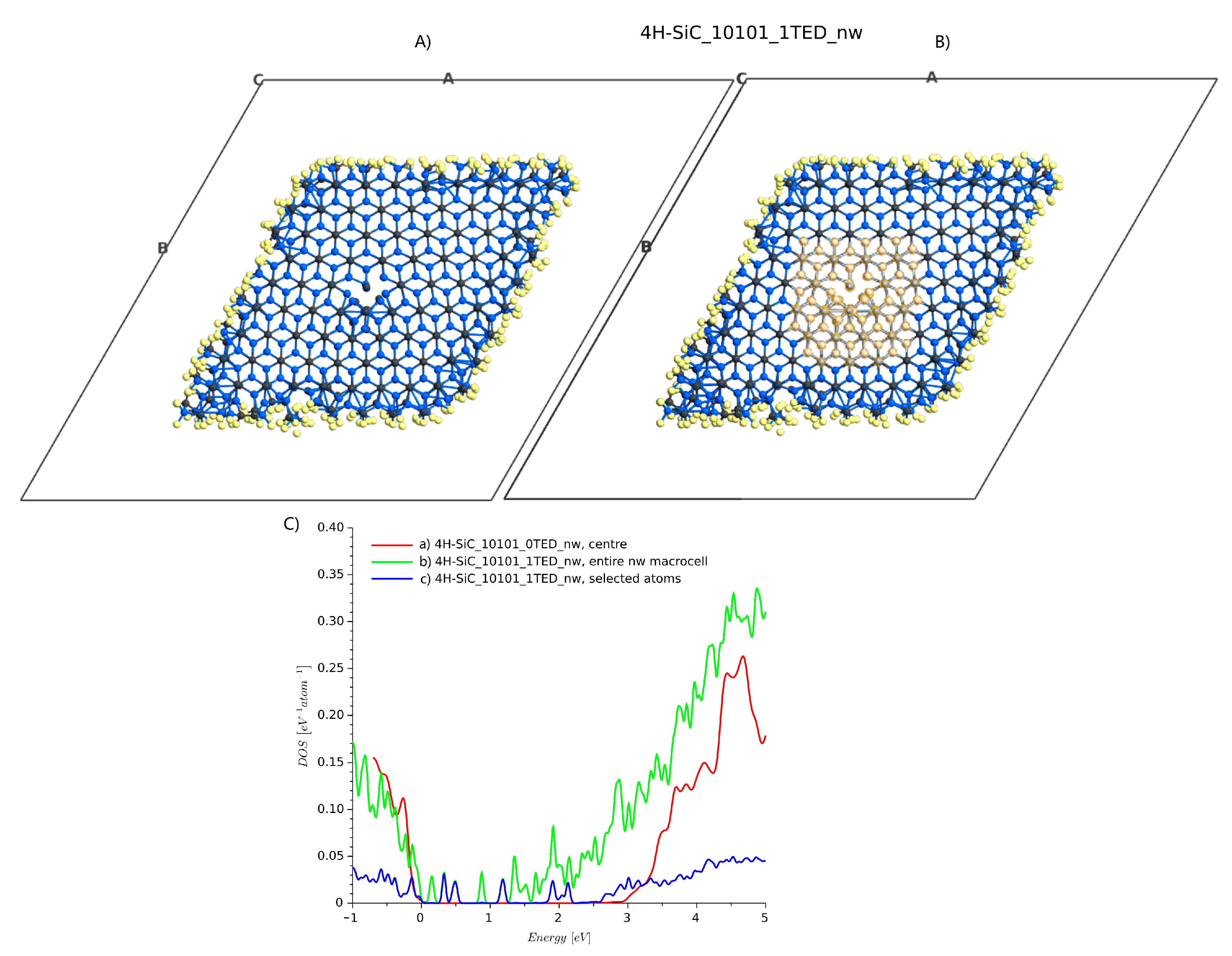Extended Hückel Semi-Empirical Approach as an Efficient Method for Structural Defects Analysis in 4H-SiC
Abstract
:1. Introduction
2. Simulation Software and Models
3. Ideal 4H-SiC
3.1. Energy Band-Gap
3.2. Density of States Function
4. Density of States for 4H-SiC with Defects
4.1. Point Defects
4.2. Shockley Stacking Fault Defects
4.3. Threading Edge Dislocations
4.3.1. Bulk Structure
4.3.2. Nanowire Structure
5. Summary and Discussion
Author Contributions
Funding
Institutional Review Board Statement
Informed Consent Statement
Data Availability Statement
Conflicts of Interest
Abbreviations
| DFT | density functional theory |
| DOS | density of states |
| GGA | generalized gradient approximation |
| HSE | Heyd–Scuseria–Ernzerhof hybrid functional approach |
| LCAO | linear combination of atomic orbitals |
| LCAO-HSE | hybrid-functional method for linear combination of atomic orbitals |
| MBJLDA | modified Becke Johnson functional combined with local density approximation |
| MetaGGA | meta-generalized gradient approximation |
| PBEs | Perdew- Burke- Ernzerhof functionals for solids |
| PDOS | projected density of states |
| PW | plane wave |
| PW-HSE | hybrid-functional calculations with plane-wave basis sets |
| SD | screw dislocations |
| SEeH | semi-empirical extended Hückel |
| SSF | Shockley stacking fault |
References
- Amano, H.; Baines, Y.; Beam, E.; Borga, M.; Bouchet, T.; Chalker, P.R.; Charles, M.; Chen, K.J.; Chowdhury, N.; Chu, R.; et al. The 2018 GaN power electronics roadmap. J. Phys. D Appl. Phys. 2018, 51, 163001. [Google Scholar] [CrossRef]
- Wolfspeed (Cree, Inc.). Silicon Carbide Materials Catalog; Brochure: Durham, NC, USA, 2019. [Google Scholar]
- Liu, C.J.; Peng, T.; Wang, B.; Guo, Y.; Lou, Y.; Zhao, N.; Wang, W.; Chen, X.L. Progress in Single Crystal Growth of Wide Bandgap Semiconductor SiC. In Materials Science Forum; Trans Tech Publ: Stafa-Zurich, Switzerland, 2019; Volume 954, pp. 35–45. [Google Scholar]
- Ayedh, H.M.; Hallén, A.; Svensson, B.G. Elimination of carbon vacancies in 4H-SiC epi-layers by near-surface ion implantation: Influence of the ion species. J. Appl. Phys. 2015, 118, 175701. [Google Scholar] [CrossRef]
- Feng, G.; Suda, J.; Kimoto, T. Characterization of major in-grown stacking faults in 4H-SiC epilayers. Phys. B Condens. Matter 2009, 404, 4745–4748. [Google Scholar] [CrossRef]
- Materials Design Inc. MedeA®, ver. 2.14, 2015. Available online: https://www.materialsdesign.com (accessed on 5 March 2021).
- Kresse, G.; Furthmüller, J. Efficient iterative schemes for ab initio total-energy calculations using a plane-wave basis set. Phys. Rev. B 1996, 54, 11169. [Google Scholar] [CrossRef]
- Smidstrup, S.; Markussen, T.; Vancraeyveld, P.; Wellendorff, J.; Schneider, J.; Gunst, T.; Verstichel, B.; Stradi, D.; Khomyakov, P.A.; Vej-Hansen, U.G.; et al. QuantumATK: An integrated platform of electronic and atomic-scale modelling tools. J. Phys. Condens. Matter 2020, 32, 015901. [Google Scholar] [CrossRef] [PubMed]
- Giannozzi, P.; Baroni, S.; Bonini, N.; Calandra, M.; Car, R.; Cavazzoni, C.; Ceresoli, D.; Chiarotti, G.L.; Cococcioni, M.; Dabo, I.; et al. QUANTUM ESPRESSO: A modular and open-source software project for quantum simulations of materials. J. Phys. Condens. Matter 2009, 21, 395502. [Google Scholar] [CrossRef]
- Cui, Q.; Elstner, M. Density functional tight binding: Values of semi-empirical methods in an ab initio era. Phys. Chem. Chem. Phys. 2014, 16, 14368–14377. [Google Scholar] [CrossRef] [PubMed]
- Elstner, M.; Porezag, D.; Jungnickel, G.; Elsner, J.; Haugk, M.; Frauenheim, T.; Suhai, S.; Seifert, G. Self-consistent-charge density-functional tight-binding method for simulations of complex materials properties. Phys. Rev. B 1998, 58, 7260–7268. [Google Scholar] [CrossRef]
- Stokbro, K.; Petersen, D.E.; Smidstrup, S.; Blom, A.; Ipsen, M.; Kaasbjerg, K. Semiempirical model for nanoscale device simulations. Phys. Rev. B 2010, 82, 075420. [Google Scholar] [CrossRef] [Green Version]
- Matos, M. Electronic structure of several polytypes of SiC: A study of band dispersion from a semi-empirical approach. Phys. B Condens. Matter 2002, 324, 15–33. [Google Scholar] [CrossRef]
- de Souza Martins, A.; Veríssimo-Alves, M. Group-IV nanosheets with vacancies: A tight-binding extended Hückel study. J. Phys. Condens. Matter 2014, 26, 365501. [Google Scholar] [CrossRef]
- Akimov, A.V.; Prezhdo, O.V. Analysis of self-consistent extended Hückel theory (SC-EHT): A new look at the old method. J. Math. Chem. 2015, 53, 528–550. [Google Scholar] [CrossRef]
- Cerdá, J.; Soria, F. Accurate and transferable extended Hückel-type tight-binding parameters. Phys. Rev. B 2000, 61, 7965–7971. [Google Scholar] [CrossRef] [Green Version]
- Blöchl, P.E.; Jepsen, O.; Andersen, O.K. Improved tetrahedron method for Brillouin-zone integrations. Phys. Rev. B 1994, 49, 16223–16233. [Google Scholar] [CrossRef]
- Chen, C.; Cheng, K.C.; Chagarov, E.; Kanicki, J. Crystalline In–Ga–Zn–O density of states and energy band structure calculation using density function theory. Jpn. J. Appl. Phys. 2011, 50, 091102. [Google Scholar] [CrossRef]
- Levinshtein, M.E.; Rumyantsev, S.L.; Shur, M.S. Properties of Advanced Semiconductor Materials: GaN, AIN, InN, BN, SiC, SiGe; John Wiley & Sons: Hoboken, NJ, USA, 2001. [Google Scholar]
- QuantumATK version R-2020.09-SP1, Synopsys QuantumATK. Available online: www.synopsys.com/silicon/quantumatk.html (accessed on 5 March 2021).
- Matsushita, Y.I.; Furuya, S.; Oshiyama, A. Floating electron states in covalent semiconductors. Phys. Rev. Lett. 2012, 108, 246404. [Google Scholar] [CrossRef]
- Matsushita, Y.I.; Oshiyama, A. Interstitial Channels that Control Band Gaps and Effective Masses in Tetrahedrally Bonded Semiconductors. Phys. Rev. Lett. 2014, 112, 136403. [Google Scholar] [CrossRef] [Green Version]
- Matsushita, Y.I.; Oshiyama, A. Comprehensive Study on Band-Gap Variations in sp 3-Bonded Semiconductors: Roles of Electronic States Floating in Internal Space. J. Phys. Soc. Jpn. 2017, 86, 054702. [Google Scholar] [CrossRef] [Green Version]
- Becke, A.D.; Johnson, E.R. A simple effective potential for exchange. J. Chem. Phys. 2006, 124, 221101. [Google Scholar] [CrossRef]
- Tran, F.; Blaha, P. Accurate band gaps of semiconductors and insulators with a semilocal exchange-correlation potential. Phys. Rev. Lett. 2009, 102, 226401. [Google Scholar] [CrossRef] [Green Version]
- Woźny, J.; Ruta, Ł.; Kubiak, A.; Lisik, Z.; Podgórski, J.; Kovalchuk, A.; Szczecińska, N.; Bugalski, P. Effect of point defects for 4H-SiC band structure by the means of ab initio calculation. In Microtechnology and Thermal Problems in Electronics; An optional note; Podgorski, J., Ed.; Lodz University of Technology: Lodz, Poland, 2017; p. 113. [Google Scholar]
- Wozny, J.; Kovalchuk, A.; Lisik, Z.; Podgorski, J.; Bugalski, P.; Kubiak, A.; Ruta, L. DFT simulation of stacking faults defects in 4H-SiC. In Proceedings of the 2018 XIV-th International Conference on Perspective Technologies and Methods in MEMS Design (MEMSTECH), Lviv Oblast, Ukraine, 18–22 April 2018; pp. 65–68. [Google Scholar] [CrossRef]
- Ren-Xu, J.; Yu-Ming, Z.; Yi-Men, Z. First-principle calculation on the defect energy level of carbon vacancy in 4H—SiC. Chin. Phys. B 2010, 19, 107105. [Google Scholar] [CrossRef]
- Devanathan, R.; de la Rubia, T.D.; Weber, W.J. Displacement threshold energies in β-SiC. J. Nucl. Mater. 1998, 253, 47–52. [Google Scholar] [CrossRef]
- Fujihira, K.; Kimoto, T.; Matsunami, H. High-purity and high-quality 4H–SiC grown at high speed by chimney-type vertical hot-wall chemical vapor deposition. Appl. Phys. Lett. 2002, 80, 1586–1588. [Google Scholar] [CrossRef] [Green Version]
- Storasta, L.; Bergman, J.; Janzén, E.; Henry, A.; Lu, J. Deep levels created by low energy electron irradiation in 4 H-SiC. J. Appl. Phys. 2004, 96, 4909–4915. [Google Scholar] [CrossRef]
- Litton, C.; Johnstone, D.; Akarca-Biyikli, S.; Ramaiah, K.; Bhat, I.; Chow, T.; Kim, J.; Schubert, E. Effect of C/ Si ratio on deep levels in epitaxial 4H–SiC. Appl. Phys. Lett. 2006, 88, 121914. [Google Scholar] [CrossRef] [Green Version]
- Matsunami, H.; Kimoto, T. Step-controlled epitaxial growth of SiC: High quality homoepitaxy. Mater. Sci. Eng. R Rep. 1997, 20, 125–166. [Google Scholar] [CrossRef]
- Kimoto, T.; Iijima, A.; Tsuchida, H.; Miyazawa, T.; Tawara, T.; Otsuki, A.; Kato, T.; Yonezawa, Y. Understanding and reduction of degradation phenomena in SiC power devices. In Proceedings of the 2017 IEEE International Reliability Physics Symposium (IRPS), Monterey, CA, USA, 2–6 April 2017; pp. 2A-1.1–2A-1.7. [Google Scholar]
- Łażewski, J.; Jochym, P.T.; Piekarz, P.; Sternik, M.; Parlinski, K.; Cholewiński, J.; Dłużewski, P.; Krukowski, S. DFT modelling of the edge dislocation in 4H-SiC. J. Mater. Sci. 2019, 54, 10737–10745. [Google Scholar] [CrossRef] [Green Version]
- Hirel, P. Atomsk: A tool for manipulating and converting atomic data files. Comput. Phys. Commun. 2015, 197, 212–219. [Google Scholar] [CrossRef]
- Li, J. AtomEye: An efficient atomistic configuration viewer. Model. Simul. Mater. Sci. Eng. 2003, 11, 173–177. [Google Scholar] [CrossRef]
- Skryshevsky, V.A.; Serdiuk, T.; Zakharko, Y.E.; Alekseev, S.A.; Géloën, A.; Lysenko, V. Preparation, Luminescent Properties and Bioimaging Application of Quantum Dots Based on Si and SiC. In Functional Nanomaterials and Devices for Electronics, Sensors and Energy Harvesting; Springer: Berlin/Heidelberg, Germany, 2014; pp. 323–348. [Google Scholar]










| Model | Energy Band-Gap (eV) | ||
|---|---|---|---|
| 3C-SiC | 4H-SiC | 6H-SiC | |
| Extended Hückel semi-empirical with Cerda parameters | 2.15 | 3.22 | 2.90 |
| PW-HSE 1 | 2.27 | 3.23 | 2.95 |
| LCAO-HSE 2 | 2.26 | 3.19 | 2.94 |
| Reference values in the literature | 2.36 | 3.23 | 3.00 |
| Structure | Sequence of Layers | Number of Atoms | ||
|---|---|---|---|---|
| 4H-SiC_0SSF | ABCB|ABCB|ABCB|ABCB | 32 | 3.25 | 0.0 |
| 4H-SiC_1SSF | ABCB|ABCB|CABA|C|ABCB|ABCB | 42 | 2.95 | 0.3 |
| 4H-SiC_2SSF | ABCB|ABCA|BCAC|BC|ABCB|ABCB | 44 | 2.5 | 0.75 |
| 4H-SiC_3SSF | ABCB|ACAB|CABA|C|ABCB|ABCB | 42 | 2.6 | 0.65 |
| 4H-SiC_4SSF | ABCB|ACBC|ABCB|ABCB | 32 | 2.7 | 0.55 |
Publisher’s Note: MDPI stays neutral with regard to jurisdictional claims in published maps and institutional affiliations. |
© 2021 by the authors. Licensee MDPI, Basel, Switzerland. This article is an open access article distributed under the terms and conditions of the Creative Commons Attribution (CC BY) license (http://creativecommons.org/licenses/by/4.0/).
Share and Cite
Wozny, J.; Kovalchuk, A.; Podgorski, J.; Lisik, Z. Extended Hückel Semi-Empirical Approach as an Efficient Method for Structural Defects Analysis in 4H-SiC. Materials 2021, 14, 1247. https://doi.org/10.3390/ma14051247
Wozny J, Kovalchuk A, Podgorski J, Lisik Z. Extended Hückel Semi-Empirical Approach as an Efficient Method for Structural Defects Analysis in 4H-SiC. Materials. 2021; 14(5):1247. https://doi.org/10.3390/ma14051247
Chicago/Turabian StyleWozny, Janusz, Andrii Kovalchuk, Jacek Podgorski, and Zbigniew Lisik. 2021. "Extended Hückel Semi-Empirical Approach as an Efficient Method for Structural Defects Analysis in 4H-SiC" Materials 14, no. 5: 1247. https://doi.org/10.3390/ma14051247







